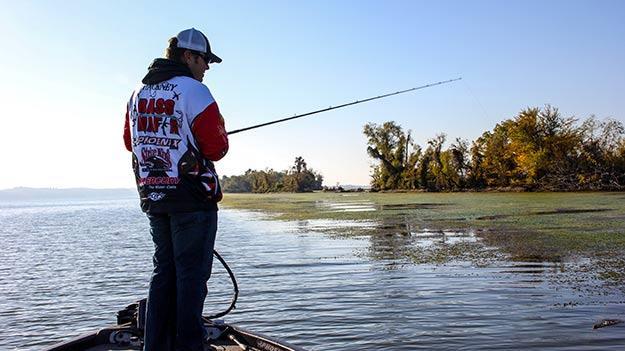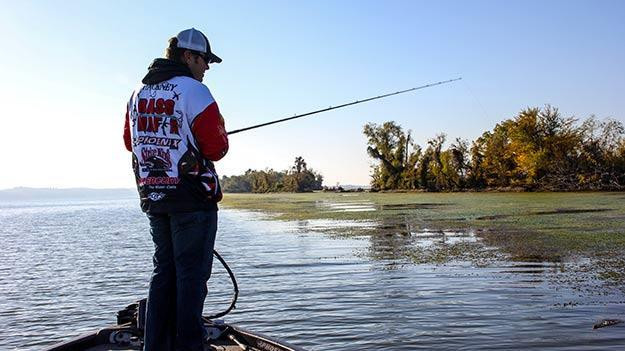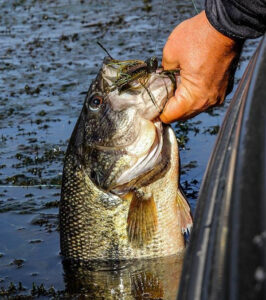Anglers either love it or hate it. Fishing grass can be some of the best experiences or some of the most frustrating and that’s generally determined by an angler’s attitude and strategy. Just because there is grass doesn’t mean you ignore all the other variables in fishing. How you fish grass is important, but knowing where in a field of grass to fish is probably more important
We picked Greg Hackney’s brain about how he likes to fish grass and ran a video series, but folks have asked us to organized his thoughts into an article. We broke it down to essentially four easy parts:
- Seasonal approach
- Lure choices
- Line choices
- Identifying grass
Four seasons of grass fishing
“I find more times than not that grass fishing has more to do with the bottom than it does the grass,” Hackney said. “It’s more about the hard bottoms, sandy bottoms, spawning areas around the grass depending on the season and the fishery.”
In the early spring the fish will get on inside edges of grass. As the summer sets in, they may get in and under the grass more as it mats up and makes cooler, cleaner and darker areas for them to ambush. In the fall we often target bass on those outside edges. If the grass stays in some capacity, bass can relate to those grass edges on river breaks and such all through the winter. Even grass that goes dormant and gets real short in the cooler months will hold populations of bass.
Grass can keep fish from making big migrations from the main lake to the backs of the bays. Hackney has found on many fisheries that the presence of grass keeps bass in one general area through prespawn, spawn, post spawn, summer, fall and winter. As the lakes fluctuate, the bass just reposition in proximity to the grass and forage relating to the grassy areas.
Pressure can also reposition bass on grass areas. Hackney still looks for those structural changes like creek channel bends, points and humps and then targets the grass on those changes. But often the best places can get too much angling pressure and you have to adapt how you fish grass or move down slightly to find where those bass have repositioned in the grass away from the key areas.
Choose the best baits not your favorite baits
Folks probably think all Hackney does if flip and pitch grass with jigs. If he had his choice that would be right, but fishing grass is like anything else. You choose the tool that fits the situation, not your favorite technique.
In the early spring period when the grass is often shorter and more submerged than later in the year, Hackney focuses on lures that cover water and draw reaction strikes like a Strike King Red Eye Shad or his Strike King Hack Attack Heavy Cover Spinnerbait fished over and around the grass edges. Bass will get shallower in colder water around grass than they will on lakes without grass. They will get up there even in water as cool as 40 degrees. He likes to fish over the grass and just tick the tops of it and ripping it out when it snags for a reaction bite.
As it warms up he starts targeting the bass spawning around the inside edges of the grass with a Strike King KVD 1.5. He thinks those bass cruising and looking to spawn react better to that smaller profile worked on the inside edge of grass and ripped off the top of submerged grass.
Flipping and pitching also starts to be effective with soft plastics like beavers or soft stick baits around the spawn.
After the spawn he really likes a topwater bait like the new Strike King Sexy Dawg or the KVD Sexy Frog. He also likes a spinnerbait with a big blade during this period when he’s targeting grass fish around the shad spawn.
As the grass gets matted and thickens in the warmer months. He’ll go with his Strike King Hack Attack Jig or a Strike King Rodent. He goes with the heaviest weight he can get away with because he can be more efficient punching through quickly. But if he’s not getting bites, he will go down in weight for a slower more enticing fall.
He’ll stick with the jig and rodent one-two punch all the way to winter.
Your line can make grass fishing easy or difficult
When you talk fishing grass, anglers automatically think power fishing with big heavy line. And that’s true to an extent. But Hackney chooses his line based on the fish behavior and time of the year.
When he’s fishing lipless baits early in the year, he’ll use braid because he wants to clear his bait of grass easily and quickly. Since the fish are cold, they won’t jump and throw the trebles as easily either on the no-stretch line.
When he’s flipping or pitching, he always goes with braid because the bass can’t differentiate the braid from the grass. He will go with fluorocarbon if he’s pitching a stick bait to the inside or outside edges of the grass because the fish are looking at it more in open water.
With his spinnerbaits, topwaters and crankbaits he’s usually going with fluorocarbon and monofilament especially as the water warms up and the fish have softer mouths and he wants to keep them hooked better with the give of monofilament. Still he uses heavy line—20-pound line with the mono and fluoro and 65-pound with the braid—around grass to give him more control and power to move fish over and out of the grass.
Identifying your grass improves your approach
Folks often get hung up on types of grass and scientific names for them. Most good grass anglers identify two types of grass — “under grass” and “next-to grass.” Hydrilla, Milfoil, Lily Pads, Hyacinths and some other grasses grow with thin stalks but lay over or form large canopies over the top of bass. These are the types of grasses that form the famous mats that anglers love to punch. While grasses like Coontail, Tules, Pencil Reeds, Arrow Heads and other types of grass that are thick and grow close together, form “edges” that the bass will get on top of or next to.
The type of grass isn’t as important as recognizing whether the bass will setup under or next to the grass. That will also help decide which lures offer the best presentations. Grasses like hydrilla tend to be the most popular because they can form edges and canopies and it gives the bass and anglers a lot more good options.
Most of the grasses will be shorter in colder water allowing you to fish baits over them. As they grow and the water warms they will create canopies or fedges to fish more. Sometimes fishing can be as easy as knowing the bass are on the inside grass lines or outside grass lines.
Learning to find grass near other structural changes, with the right bottom composition and then reading the grass in those areas to make educated choices on line and lure selection will take most of the frustration out of grass fish.
To learn more on how Hackney targets grass fish, check out this series of videos:














